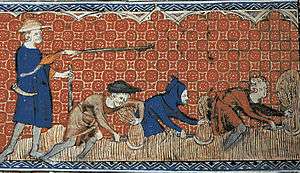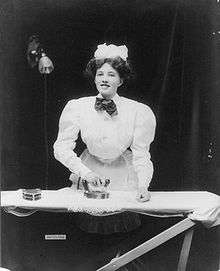Domestic worker
A domestic worker is a person who works within an employer's household. The term "domestic service" applies to the equivalent occupational category. In traditional English contexts, such a person was said to be "in service".[1] Domestic helpers perform a variety of household services for an individual or a family, from providing care for children and elderly dependents to housekeeping, including cleaning and household maintenance. Other responsibilities may include cooking, laundry and ironing, shopping for food and other household errands. Such work has always needed to be done but before the Industrial Revolution and the advent of labour saving devices, it was physically much harder.

Some domestic helpers live within their employer's household. In some cases, the contribution and skill of servants whose work encompassed complex management tasks in large households have been highly valued. However, for the most part, domestic work tends to be demanding and is commonly considered to be undervalued, despite often being necessary. Although legislation protecting domestic workers is in place in many countries, it is often not extensively enforced. In many jurisdictions, domestic work is poorly regulated and domestic workers are subject to serious abuses, including slavery.[2]
Servant is an older English word for "domestic worker", though not all servants worked inside the home. Domestic service, or the employment of people for wages in their employer's residence, was sometimes simply called "service" and has often been part of a hierarchical system. In Britain a highly developed system of domestic service peaked towards the close of the Victorian era, perhaps reaching its most complicated and rigidly structured state during the Edwardian period (a period known in the United States as the Gilded Age and in France as the Belle Époque), which reflected the limited social mobility before World War I.
Terminology
Other terms include domestic helper, domestic servant, manservant or menial.
History
ILO estimates in 2015, based on national surveys and/or censuses of 232 countries and territories, place the number of domestic workers at around 67.1 million.[3] But the ILO itself states that "experts say that due to the fact that this kind of work is often hidden and unregistered, the total number of domestic workers could be as high as 100 million".[4] The ILO also states that 83% of domestic workers are women and many are migrant workers.
In Guatemala, it is estimated that eight percent of all women work as domestic workers. They hardly have any legal protection. According to Guatemalan labor law, domestic work is "subject neither to a working time statute nor to regulations on the maximum number of working hours in a day". Legally, domestic helpers are only entitled to ten hours of free time in 24 hours, and one day off per week. But very often, these minimal employment laws are disregarded, and so are basic civil liberties.[5]
In Brazil, domestic workers must be hired under a registered contract and have many of the rights of any other workers, which includes a minimum wage, remunerated vacations and a remunerated weekly day off. It is not uncommon, however, for employers to hire servants illegally and fail to offer a work contract. Since domestic staff predominantly come from disadvantaged groups with less access to education, they are often vulnerable and uninformed of their rights, especially in rural areas. Nevertheless, domestics employed without a proper contract can successfully sue their employers and be compensated for abuse committed. It is common in Brazil for domestic staff, including childcare staff, to be required to wear uniforms, while this requirement has fallen out of use in other countries.
In the United States, domestic workers are generally excluded from many of the legal protections afforded to other classes of worker, including the provisions of the National Labor Relations Act.[6] However, in recent years, advocacy groups like the National Domestic Workers' Alliance have succeeded in passing a Domestic Workers' Bill of Rights into state law in New York, Hawaii, and California.[7]
Traditionally domestic workers have mostly been women and are likely to be immigrants.[8] Currently, there are 1.8 million domestic workers, and tens of thousands of people are believed to be in forced labor in the United States.[9] America's domestic home help workers, most of them female members of minority groups, earn low wages and often receive no retirement or health benefits because the lack of basic labor protections.
Domestic workers are also excluded from vacation time, sick time, and overtime, and only thirteen percent of domestic workers get health insurance provided by their employers. A report from the National Domestic Workers Alliance and affiliated groups found that nearly a quarter of nannies, caregivers, and home health workers make less than the minimum wage in the states in which they work, and nearly half – 48 percent – are paid less than needed to adequately support a family.[10][11] Many of these workers are subjected to abuse, sexual harassment, and social inequality. However, because domestic workers work in the home, their struggles are hidden in the home and out of the public spotlight. Nowadays with an increase of power, the domestic workers' community has formed many organizations, such as the National Domestic Workers Alliance, Domestic Workers United, and The South African Domestic Service and Allied Workers Union.[12]

The domestic work industry is dominated throughout the world by women.[13] While the domestic work industry is advantageous for women in that it provides them a sector that they have substantial access to, it can also prove to be disadvantageous by reinforcing gender inequality through the idea that domestic work is an industry that should be dominated by women. Within the domestic work industry, the much smaller proportion of jobs that is occupied by men are not the same jobs that are typically occupied by women. Within the childcare industry, men make up only about 3–6% of all workers.[14] Additionally, in the child care industry men, are more likely to fill roles that are not domestic in nature but administrative such as a managerial role in a daycare center.[15]
While the domestic work industry was once believed to be an industry that belonged to a past type of society and did not belong in a modern world, trends are showing that although elements of the domestic work industry have been changing the industry itself has shown no signs of fading away, but only signs of transformation.[14] There are several specific causes that are credited to continuing the cycle of the demand for domestic work. One of these causes is that with more women taking up full-time jobs, a dually employed household with children places a heavy burden on parents. It is argued however that this burden wouldn't result in the demand for outside domestic help if men and women were providing equal levels of effort in domestic work and child-rearing within their own home.[16]
The demand for domestic workers has also become primarily fulfilled by migrant domestic workers from other countries who flock to wealthier nations to fulfill the demand for help at home.[13][17] This trend of domestic workers flowing from poorer nations to richer nations creates a relationship that on some levels encourages the liberation of one group of people at the expense of the exploitation of another.[13] Although domestic work has far from begun to fade from society, the demand for it and the people who fill that demand has changed drastically over time.
Legal protections
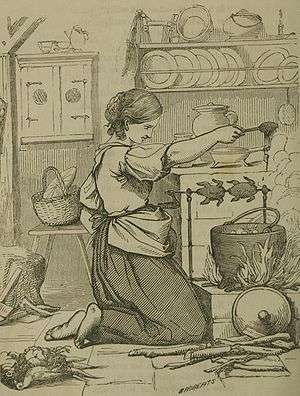
The United Kingdom's Master and Servant Act 1823 was the first of its kind; the terms referred generally to employers and employees. The Act influenced the creation of domestic service laws in other nations, although legislation tended to favour employers. However, before the passing of such Acts servants, and workers in general, had no protection in law. The only real advantage that domestic service provided was the provision of meals, accommodation, and sometimes clothes, in addition to a modest wage. Service was normally an apprentice system with room for advancement through the ranks.
The conditions faced by domestic workers have varied considerably throughout history and in the contemporary world. In the course of twentieth-century movements for labour rights, women's rights and immigrant rights, the conditions faced by domestic workers and the problems specific to their class of employment have come to the fore.
In 2011, the International Labour Organization adopted the Convention Concerning Decent Work for Domestic Workers. Previously, at its 301st Session (March 2008), the International Labour Organization (ILO) Governing Body agreed to place an item on decent work for domestic workers on the agenda of the 99th Session of the International Labour Conference (2010) with a view to the setting of labour standards.[18] In July 2011, at the annual International Labour Conference, held by the ILO, conference delegates adopted the Convention on Domestic Workers by a vote of 396 to 16, with 63 abstentions. The Convention recognized domestic workers as workers with the same rights as other workers. On 26 April 2012, Uruguay was the first country to ratify the convention.[19][20]
Accommodation

Many domestic workers are live-in domestics. Though they often have their own quarters, their accommodations are not usually as comfortable as those reserved for the family members. In some cases, they sleep in the kitchen or small rooms, such as a box room, sometimes located in the basement or attic. Domestic workers may live in their own home, though more often they are "live-in" domestics, meaning that they receive their room and board as part of their salaries. In some countries, because of the large gap between urban and rural incomes, and the lack of employment opportunities in the countryside, even an ordinary middle class urban family can afford to employ a full-time live-in servant. The majority of domestic workers in China, Mexico, India, and other populous developing countries, are people from the rural areas who are employed by urban families.
Employers may require their domestic workers to wear a uniform, livery or other "domestic workers' clothes" when in their employers' residence. The uniform is usually simple, though aristocratic employers sometimes provided elaborate decorative liveries, especially for use on formal occasions. Female servants wore long, plain, dark-coloured dresses or black skirts with white belts and white blouses, and black shoes, and male servants and butlers would wear something from a simple suit, or a white dress shirt, often with tie, and knickers. In traditional portrayals, the attire of domestic workers especially was typically more formal and conservative than that of those whom they serve. For example, in films of the early 20th century, a butler might appear in a tailcoat, while male family members and guests appeared in lounge suits or sports jackets and trousers depending on the occasion. In later portrayals, the employer and guests might wear casual slacks or even jeans, while a male domestic worker wore a jacket and tie or a white dress shirt with black trousers, necktie or bowtie, maybe even waistcoat, or a female domestic worker either a blouse and skirt (or trousers) or a uniform.
On 30 March 2009, Peru adopted a law banning employers from requiring domestic workers to wear a uniform at public places. However, it's not explained which punishments will be given to employers violating the law.[21] Chile adopted a similar law in 2014, also banning employers to require domestic workers to wear uniform at public places.[22][23]
Child workers
More girls under 16 work as domestic workers than any other category of child labor.[24] Usually, in a practice often called "confiage" or entrusting, such as for restaveks in Haiti, parents in the rural poverty make an agreement with someone in the cities who would house and send their child to school in return for domestic work.[25]
Such children are very vulnerable to exploitation: often they are not allowed to take breaks or are required to work long hours; many suffer from a lack of access to education, which can contribute to social isolation and a lack of future opportunity. UNICEF considers domestic work to be among the lowest status, and reports that most child domestic workers are live-in workers and are under the round-the-clock control of their employers.[26] Child domestic work is common in countries such as Bangladesh and Pakistan.[27][28] In Pakistan, since January 2010 to December 2013, 52 cases of tortures on child domestic workers are reported including 24 deaths.[29] It has been estimated that globally, at least 10 million children work in domestic labor jobs.[28]
Children face a number of risks that are common in domestic work service. The International Programme on the Elimination of Child Labour identified that these risks include: long and tiring working days; use of toxic chemicals; carrying heavy loads; handling dangerous items such as knives, axes and hot pans; insufficient or inadequate food and accommodation, and humiliating or degrading treatment including physical and verbal violence, and sexual abuse.[30]
Migrant domestic workers
Migrant domestic workers are, according to the International Labour Organization’s Convention No. 189 and the International Organization for Migration, any persons “moving to another country or region to better their material or social conditions and improve the prospect for themselves or their family,”[31] engaged in a work relationship performing “in or for a household or households.”[32] Domestic work itself can cover a "wide range of tasks and services that vary from country to country and that can be different depending on the age, gender, ethnic background and migration status of the workers concerned."[33] These particular workers have been identified by some academics as situated within "the rapid growth of paid domestic labor, the feminization of transnational migration, and the development of new public spheres.”[34]
Social effects
_lady.jpg)
As women currently dominate the domestic labor market throughout the world, they have learned to navigate the system of domestic work both in their own countries and abroad in order to maximize the benefits of entering the domestic labor market.
Among the disadvantages of working as a domestic worker is the fact that women working in this sector are working in an area often regarded as a private sphere.[16] Feminist critics of women working in the domestic sphere argue that this woman dominated market is reinforcing gender inequalities by potentially creating mistress-servant relationships between domestic workers and their employers and continuing to put women in a position of lesser power.[16] Other critics point out that working in a privatized sphere robs domestic workers of the advantages of more socialized work in the public sphere.[35]
Additionally, domestic laborers face other disadvantages. Their isolation is increased by their invisibility in the public sphere and the repetitive, intangible nature of their work decreases its value, making the workers themselves more dispensable.[36] The level of isolation women face also depends on the type of domestic work they are involved with. Live-in nannies for example may sacrifice much of their own independence and sometimes become increasingly isolated when they live with a family of which they are not part and away from their own.[37]
While working in a dominantly female privatized world can prove disadvantageous for domestic workers, many women have learned how to help one other move upward economically. Women find that informal networks of friends and families are among the most successful and commonly used means of finding and securing jobs.[38]
Without the security of legal protection, many women who work without the requisite identity or citizenship papers are vulnerable to abuse. Some have to perform tasks considered degrading showing a manifestation of employer power over worker powerlessness. Employing domestic work from foreign countries can perpetuate the idea that domestic or service work is reserved for other social or racial groups and plays into the stereotype that it is work for inferior groups of people.[39]
Gaining employment in the domestic labor market can prove to be difficult for immigrant women. Many subcontract their services to more established women workers, creating an important apprenticeship type of learning experience that can produce better, more independent opportunities in the future.[35] Women who work as domestic workers also gain some employment mobility. Once established they have the option of accepting jobs from multiple employers increasing their income and their experience and most importantly their ability to negotiate prices with their employers.[36]
Situation by country
Canada
Domestic helpers in Canada, mainly from the Philippines, work in Canada, including under the Live-In Caregiver program.
Hong Kong
Domestic helpers (DHs, foreign domestic workers, FDWs) from certain other countries, especially the Philippines and Indonesia, work in Hong Kong on specific visas that exempt employers from many obligations received by other workers, and receive a lower minimum salary. Approximately five percent of Hong Kong's population are FDWs, about 98.5% of them are women, performing household tasks such as cooking, serving, cleaning, dishwashing and child care.[40]
Kenya
In Kenya, domestic workers – nearly all female – are known as 'housegirls'. Often from poor villages in neighbouring Uganda, girls are open to exploitation, and there are calls for stronger legal protection.[41]
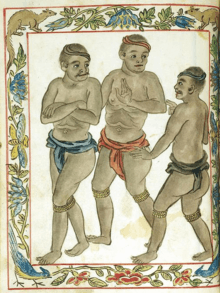
Philippines
In the Philippines, domestic household workers/helpers such as maidservants (katulong/kasambahay), caretakers (yaya), family drivers (drayber/tsuper), laundrywomen (labandera/tagalaba), gardeners (hardinero), security guards (guwardiya/bantay), pool cleaners have been a norm in upper class Philippine society for an uncertain amount of time already, perhaps even connected to or influenced from the household slaves/servants in precolonial times of the Philippines that were divided into aliping namamahay and aliping saguiguilid, as indentured household servants. In modern times, it has been a norm among upper and upper-middle-class families in the Philippines to hire at least one maidservant-caretaker (katulong/kasambahay/yaya) to care for the household and children. Most, particularly maidservant-caretakers (katulong/kasambahay/yaya), live together in the house of their master's family with usually only a day off per month. This practice has eventually influenced the architecture of some houses or apartment condos where it has become a norm to section a room where domestic maidservants sleep as their personal room, usually near the kitchen or laundry area. Some wealthy families also section off an area or house where all the maidservants sleep or a part of the kitchen where they eat separate from the master's table. There are also employment agencies and special government laws regarding the regulation of domestic worker employment, such as the "Domestic Workers Act" or "Batas Kasambahay" in Republic Act No 10361. Many live underpaid since many are informally hired or salaries are not declared truthfully to government offices or have an agreement instead to pay through other means, such as paying for their education, pension, or to send money back to their families. This practice was eventually exported to neighboring countries and all other countries that overseas Filipino workers (OFWs) have worked in, such as the United States, Canada, Hong Kong, Singapore, China, Saudi Arabia, and other countries in the Middle East, and etc., hence some maidservants continue living with the same mindset of how domestic worker culture was practiced in the Philippines. This has also, at times, been used as a cause to look down upon overseas Filipino workers (OFWs) in the countries where they can be found. It has sometimes created controversies in other countries such as abuse charges in several countries in the Middle East or like the case of Flor Contemplacion, who was executed in Singapore for murder allegations. There have also been documentaries or rom-com movies made in the Philippines about the plight or life of domestic workers, particularly maidservant-caretakers (katulong/kasambahay/yaya).
Singapore
Data from Singapore's Ministry of Manpower (MOM), showed that in June 2019 there were some 255,800 Foreign Domestic Workers (FDW) in Singapore. [42] The demand for Foreign Domestic Workers came about from the desire of the Singapore government to employ local women in the workforce. Starting with the Foreign Maid Scheme in 1978, Malaysia (with whom there were special immigration arrangements), Bangladesh, Burma, India, Indonesia, the Philippines, Sri Lanka and Thailand were recruiting grounds for domestic workers.[43] Nearly 20% of Singapore household has a domestic worker which has been attributed to rising wealth, parents who both work as well as the ageing population. As of 2019, MOM require that employers of FDWs must purchase them medical insurance with a minimum coverage of S$15,000 per year.[44]
Mistreatment of FDWs in Singapore by locals is not uncommon and has been widely reported, including physical abuse,[45][46] outraging modesty[47] and sexual assault. [48][49] Abuse is not considered acceptable by the Singapore legal system and as such there have been many cases brought against abusive employers. For example in the case of an Indonesian maid had her teeth knocked out by a hammer. On 1 August, her employer had been sentenced to 11 years’ jail and was also ordered to pay the foreign domestic worker about S$56,500 in compensation or serve an additional five months. The husband of her abuser received a sentence of 15 months’ jail and needed to pay S$1,000 in compensation.[50]
Saudi Arabia,
According to a 2008 report by Human Rights Watch (HRW), the Saudi Ministry of Labor provided official figures of 1.2 million household workers in Saudi Arabia including domestic workers, drivers, and gardeners. The report stated that the Gulf country employed nearly 1.5 million women domestic workers from Indonesia, Sri Lanka and Philippines. Domestic workers estimated approximately 600,000 from Indonesia, 275,000 from Sri Lanka and 200,000 from Philippines. However, HRW reported that a number of domestic workers in Saudi Arabia face a range of abuses. Besides, the organization also interviewed Saudi labor and social affairs official, who acknowledged the issue of domestic worker abuse. The report stated that no accurate figure exists to highlight the total violations of labor rights and other human rights that women migrant domestic workers confront in the Arab nation.[51]
United States
Blacks post-Civil War to World War I
In the United States, slavery legally ended in 1865, however, the Freedmen's Bureau informed the former slaves now classified as freedmen and women that they could either sign labor contracts with white planters or be evicted from the land that they had lived on.[52] Most freedmen in the South signed labor contracts with their former white slave owners because that was the only work experience they had. With limited skills and illiteracy, many men turned to become sharecroppers, whereas the majority of women participated in domestic work. Not only were they not qualified for other jobs, but they were denied other jobs and segregated from American society purely based on the color of their skin. The South wanted to keep segregation alive and hence passed legislation such as the Jim Crow Laws post-Civil war which denied African Americans of legal equality and political rights. These laws kept many African Americans as a second-class status up until new laws ended segregation in the 1960s.[53]
Up until the mid-twentieth century, domestic work was a prominent source of income for many women of different ethnic backgrounds. Many of these women were either African American or immigrants. More specifically, the post-civil war South had a high concentration of African Americans working as domestic workers. At the turn of the nineteenth century, there was also a high concentration of African Americans working as domestic workers in the North. Many African American women migrated to the North for better work opportunities and higher wages compared to their employment options in the South. The African American women who worked as domestic workers were generally treated as poor, childlike beings that were seen as victims of their own ignorance of living in communities of crime and other societal infringements.[52] However, despite the stereotypes labeled upon domestic workers, these women still settled for these positions because the only occupations that were open to African American women before World War I were domestic services. It was necessary they worked along with their husbands in order to keep their families financially supported.[54]
Frequently underpaid, African American servants commonly took food scraps and discarded clothing from their employers in a practice known as “pan toting” or the “service pan”.[55] The service pan augmented wages in almost two-thirds of the employers’ households in Athens, Georgia, in 1913.[56] The pan system was used by employers to justify paying a lower wage,[57] and used by domestic workers to counter their employers’ dishonesty.[55] Whites also pointed to the practice of pan toting as proof that “a Negro could not help but steal”, thereby reinforcing stereotypes of “black inferiority and dependency” and rationalizing racist paternalism.[57]
Blacks in the Great Depression
During the Great Depression, many domestic workers lost their jobs. This is because many white families lost their source of income and were not able to pay domestic workers to work in their home. At this time, many domestic workers relied on asking strangers on the street for housework such as cleaning. They house jumped, looking for any job that they could get. The domestic workforce was significantly impacted by the Great Depression which caused a decrease in their wages and an intolerable 18 hour workday. Also, agricultural workers and the African American women working as domestic workers at this time were explicitly excluded from social security and the FLSA in the New Deal legislation.[54] This is because the New Dealer politicians were more worried about losing support from the Southern Democrats in Congress who supported segregation rather than refusing coverage for many African Americans.[54] Unlike their white counterparts, African Americans did not form labor unions because they lacked the resources, consciousness, and the access to networks used for union recruiting. On top of that, the domestic workers would not typically have earned enough money to be able to afford being a part of a union. Even if the African American domestic workers wanted to advance in society, it was nearly impossible because the racial structures in the United States rarely allowed them class mobility.[54] However, domestic workers that were white such as the Irish and the Germans utilized working in middle-class homes to their advantage. Working in the middle-class homes served to Americanize, allowing the workers to identify more with their employers than women of their own class and instilled an aspiration to become middle-class status.[54]
Blacks in 1960s America
Nearly ninety percent of African American women worked as domestic workers during the Civil Rights Movement era.[52] Their participation in the Civil Rights Movement went fairly undocumented, and despite their low-status career in the United States, they were beneficial for the betterment of society and the status of the African American race. It has been noted that the southern African American women were the backbone of the Civil Rights Movement.
Since many white households relied on the African American domestic workers for housework, the workers were able to have a direct impact on the white race when rebelling for their civil rights. The African American domestic workers boycotted buses and tried to register to vote, and many were denied and imprisoned. However, the domestic workers utilized imprisonment to educate other African American women on the Civil Rights Movement and what to do to contribute. Additionally, typically the domestic workers rebelled in an informal manner, such as resisting to live in the same home in which they worked. By doing this, the African American domestic workers transformed the domestic services, and collective organizations came about promoting a better work environment for African American domestic workers. Their act of rebellion gave way for a change of how they were treated, how they were paid, and how they were respected.
Varieties of domestic workers
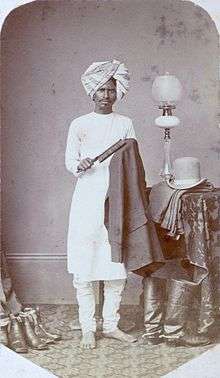
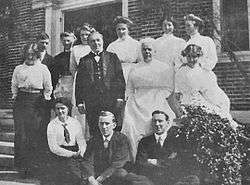
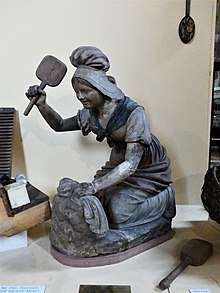
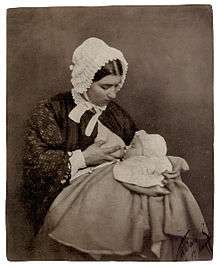
The following is a list of known domestic workers:
- Au pair – A foreign-national domestic assistant working for and living as part of, a host family.
- Amanuensis – A person employed to write or type what another dictates or to copy what has been written by another.
- Ayah – A job that is similar to a nanny's.
- Babysitter – A worker who minds the children of someone else.
- Bedder / bedmaker – A worker who makes the beds.
- Between maid – An in-between maid whose duties are half in the reception rooms and half in the kitchen.
- Bodyguard – A worker who protects his employer.
- Boot boy – A young male servant, employed mostly to perform footwear maintenance and minor auxiliary tasks.
- Butler – A senior employee usually found in larger households, almost invariably a man, whose duties traditionally include overseeing the wine cellar, the silverware and some oversight of the other, usually male, servants.
- Chambermaid – A maid whose chief focus is on cleaning and maintaining bedrooms, ensuring fires are lit in fireplaces when needed, and supplying hot water.
- Charwoman (AKA Char) – A female house or office cleaner, usually part-time.
- Chauffeur – A personal driver (for motor vehicles).
- Cleaner – A worker who cleans homes, institutions or commercial premises.
- Cook – This is either a cook who works alone or the head of a team of cooks who work for their employer.
- Dog walker – A worker who walks dogs.
- Footman – A lower-ranking manservant.
- Gardener – A worker who tends to the garden.
- Governess – A woman teacher for children.
- Groundskeeper – A worker who tends to the person's large property.
- Hall boy – The lowest ranking male servant who is usually found only in large households.
- Handyman – A worker who handles household repairs.
- Horse trainer – A worker who trains the horses for those who own them.
- Houseboy – A worker who does personal chores.
- Housekeeper – A housekeeper usually denotes a female senior employee.
- Kitchen maid – A worker who works for the cook.
- Lackey – A runner who may be overworked and underpaid.
- Lady's maid – A woman's personal attendant, helping her with her clothes, shoes, accessories, hair, and cosmetics.
- Laundress – A laundry servant.
- Maid (AKA Housemaid) – Female servants who do the typical duties.
- Majordomo – The senior-most staff member of a very large household or stately home. See also Seneschal.
- Masseur/Masseuse – A servant who performs massages.
- Nanny (AKA nurse) – A woman who takes care of infants and children.
- Nursemaid (AKA Nursery maid) – A maid who oversees the nursery.
- Personal shopper – A person who does the shopping.
- Personal trainer – A worker who trains their employer in fitness, swimming, and sports.
- Pool person – A worker who works by the swimming pool.
- Retainer – A servant, especially one who has been with one family for a long time (chiefly British English).[58]
- Scullery maid – The lowest-ranking of the domestic workers who act as assistants to the kitchen maid.
- Stable boy – A worker who handles the management of the horses and the stables.
- Valet – Known as the "gentleman's gentleman", a valet is responsible for the master's wardrobe and assisting him in dressing, shaving, etc. In the armed forces, some officers have a soldier (in the British army called a batman) for such duties.
- Wet nurse – A nurse who provides suckling for infants if mothers cannot or do not wish to do so themselves.
Notable people
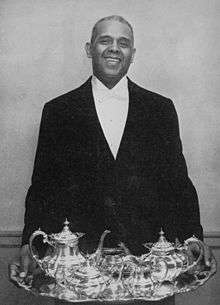
Some domestic workers have become notable, including: Abdul Karim (the Munshi), servant of Queen Victoria of Great Britain; Paul Burrell, butler to Diana, Princess of Wales; Moa Martinson, author of proletarian literature, kitchen maid; and Charles Spence, Scottish poet, stonemason and footman.
Cultural depictions
In religion
- Saint Zita, the patron saint of domestic servants
- Category:Canonised servants of the Romanov household
In fiction
- A Little Princess, a book made into several films
- Alfred Pennyworth, Bruce Wayne's faithful butler, created by Bob Kane and Bill Finger
- Amelia Bedelia, children's comedy fiction
- Beryl's Lot, a British television series based on Margaret Powell's memoirs of domestic service
- Cinderella, a fairytale, cartoon, and film
- Downton Abbey, a British television series set in a large English country house
- Edwin Jarvis, the butler of Tony Stark
- Gone with the Wind, a Pulitzer Prize-winning American novel and Academy Award-winning film
- The Diary of a Chambermaid, a novel by Octave Mirbeau
- The Help, a novel by Kathryn Stockett
- The Remains of the Day, Man Booker Prize–winning novel
- Upstairs, Downstairs, a British television series set in London
- Upstairs Downstairs (remake), a British television series set in London
- You Rang, M'Lord?, a British television comedy series
In visual art
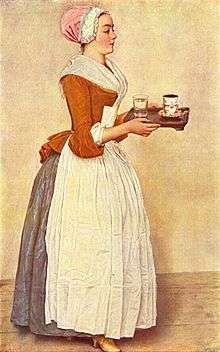 The Chocolate Girl, by Jean-Étienne Liotard (c. 1734–1744)
The Chocolate Girl, by Jean-Étienne Liotard (c. 1734–1744)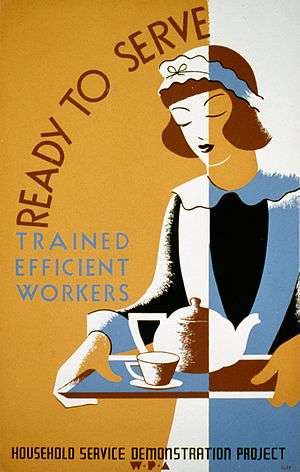 A poster of an American maid in uniform (ca. 1939)
A poster of an American maid in uniform (ca. 1939) Young water carrier drawing by Heinrich Zille (by 1929)
Young water carrier drawing by Heinrich Zille (by 1929) Colonial dining, William Henry Jackson (1895)
Colonial dining, William Henry Jackson (1895)
See also
- Ancillae
- Convention on Domestic Workers
- Domestic Worker's Bill of Rights
- Homemaking
- Hooch maid
- Housekeeping
- Isabella Beeton ("Mrs Beeton") and The Book of Household Management
- Nanny tax
- National Union of Domestic Employees
- Reproductive labor
- French maid
References
- "in service". Oxford English Dictionary (3rd ed.). Oxford University Press. September 2005. (Subscription or UK public library membership required.)
- Anti-Slavery International. "Domestic Work and Slavery". Anti-Slavery.Org. Anti-Slavery International. Archived from the original on 30 September 2014. Retrieved 24 September 2014.
- "ILO Global estimates of migrant workers and migrant domestic workers: results and methodology" (PDF). International Labour Organization. Retrieved 2016-12-23.
- "100th ILO annual Conference decides to bring an estimated 53 to 100 million domestic workers worldwide under the realm of labour standards". International Labour Organization. Archived from the original on 2016-12-27. Retrieved 2016-12-23.
- Verfürth, Eva-Maria (n.d.). "Hard work new opportunities". D+C Development and Cooperation No. 09 2009. Archived from the original on 2009-10-12. Retrieved 2009-01-10.
- See the UN Human Rights Committee's report, "Domestic Workers' Rights in the United States."
- Hilgers, Lauren (2019-02-21). "The New Labor Movement Fighting for Domestic Workers' Rights". The New York Times. ISSN 0362-4331. Retrieved 2019-03-10.
- Graff, Daniel A. (n.d.). "Domestic Work and Workers". The Electronic Encyclopedia of Chicago. Archived from the original on 2009-05-13. Retrieved 2009-08-31.
- Bello, Grace (January 17, 2013). "The Home Economics of Domestic Workers". Archived from the original on January 31, 2013.
- "Without Labor Protections, Domestic Workers Earn Low Wages And Receive No Benefits". Archived from the original on 2013-10-04.
- See the UN Human Rights Committee's report, "Domestic Workers' Rights in the United States."
- "About Us". National Domestic Workers Alliance.
- "Feminists and Domestic Workers; Muchachas No More: Domestic Workers in Latin America and the Caribbean" by Elsa M. Chaney; Mary Garcia Castro
- Susan B. Murray, "'We all love Charles': men in child care and the social construction of gender", Gender & Society; (1996) 10: 368
- Silvey, R. (2004), "Transnational Migration and the Gender Politics of Scale: Indonesian Domestic Workers in Saudi Arabia". Singapore Journal of Tropical Geography
- Arat-Koc, S. (1992) 'In the Privacy of Our Own Home: Foreign Domestic Workers as a Solution to the Crisis of the domestic sphere in Canada', P. Connelly and P. Armstrong (eds) Feminism in Action: Studies in Political Economy, Toronto: Canadian Studies Press.
- Domesticity and Dirt: Housewives and Domestic Servants in the United States, 1920–1989; by Phyllis Palmer
- "Resource guide on domestic workers". International Labour Organization. Archived from the original on October 4, 2013. Retrieved October 4, 2013.
- "Uruguay First Country to Ratify C189". Idwn.info. 2012-05-03. Archived from the original on 2012-10-25. Retrieved 2012-05-11.
- "Domestice Worker Chart". ThinkProgress. Archived from the original on October 4, 2013. Retrieved October 4, 2013.
- Guerra, Isabel (30 March 2009). "Peru: Domestic servants can no longer be forced to wear uniforms in public". Living in Peru. Archived from the original on 16 January 2017. Retrieved 19 March 2011.
- "Housemaid-turned-rapper gives voice to suffering of domestic helpers in Latin America". South China Morning Post. 4 August 2016. Archived from the original on 19 January 2017. Retrieved 15 January 2017.
- "Brazil rapper voices Latin housemaids' suffering". New Strait Times. 4 August 2016. Archived from the original on 19 January 2017. Retrieved 15 January 2017.
- "Child domestic workers: Finding a voice" (PDF). Antislavery.com. Archived (PDF) from the original on April 3, 2013. Retrieved October 4, 2013.
- Sullivan, Kevin (26 December 2008). "In Togo, a 10-Year-Old's Muted Cry: 'I Couldn't Take Any More'". Washington Post. Retrieved 27 May 2018.
- "Counting Cinderellas Child Domestic Servants – Numbers and Trends". Archived from the original on 2011-08-23.
- "Archived copy" (PDF). Archived from the original (PDF) on 2012-01-18. Retrieved 2011-05-02.CS1 maint: archived copy as title (link)
- Archived April 10, 2009, at the Wayback Machine
- "The ISJ demands immediate ban on child domestic labour in Pakistan | The Institute for Social Justice". ISJ. 2014-01-07. Archived from the original on 2014-01-11. Retrieved 2014-07-15.
- "Ending child labour in domestic work and protecting young workers from abusive working conditions".
- "International Organization for Migration: Key Migration Terms".
- "International Labour Organization: Domestic Work".
- International Labour Organization. "Domestic work". International Labour Organization. Retrieved 10 December 2013.
- Moors, Annelies; et al. (2009). Migrant Domestic Workers: A New Public Presence in the Middle East?. Social Science Research Council. pp. 177–202.
- "Ways to Come, Ways to Leave: Gender, Mobility, and Il/legality among Ethiopian Domestic Workers in Yemen", Gender & Society; 2010 24: 237, Marina De Regt
- Regulating the Unregulated?: Domestic Workers' Social Networks, Pierrette Hondagneu-Sotelo, Social Problems, Vol. 41, No. 1, Special Issue on Immigration, Race, and Ethnicity in America (Feb., 1994), pp. 50–64
- Pratt, Geraldine. "From Registered Nurse to Registered Nanny: Discursive Geographies of Filipina Domestic Workers in Vancouver, BC*." Economic Geography 75.3 (1999): 215–236.
- Andall, Jacqueline. "Organizing domestic workers in Italy: the challenge of gender, class and ethnicity." Gender and Migration in Southern Europe (2000): 145–171.
- Just Another Job? Paying for Domestic Work, Bridget Anderson Gender and Development, Vol. 9, No. 1, Money (Mar., 2001), pp. 25–33
- Miquiabas, Bong (31 March 2015). "After Another Nightmare Surfaces in Hong Kong's Domestic Worker Community, Will Anything Change?". Forbes.
- The hidden lives of ‘housegirls’ in Kenya, BBC, 20 May 2019
- "Foreign workforce numbers". Ministry of Manpower Singapore. Retrieved 2020-04-02.
- "Foreign Domestic Workers in Singapore: Social and Historical Perspectives" (PDF).
- "The Big Read: As maids become a necessity for many families, festering societal issues could come to the fore". CNA. Retrieved 2020-04-07.
- "Woman on trial for abusing maid; asked her to shower in front of her, assaulted her privates". CNA. Retrieved 2020-04-02.
- "Woman asked maid to punch herself 50 times, strike her teeth with meat pounder until they 'dropped'". CNA. Retrieved 2020-04-02.
- "Man gets jail for filming family's maid in shower". CNA. Retrieved 2020-04-02.
- "Man gets jail, caning for raping maid after asking her for massage". CNA. Retrieved 2020-04-02.
- hermes (2016-11-15). "First conviction in Singapore of employer raping maid". The Straits Times. Retrieved 2020-04-02.
- "Jail for woman who hammered out maid's teeth in 'worst' recent case of abuse". CNA. Retrieved 2020-04-07.
- ""As If I Am Not Human" Abuses against Asian Domestic Workers in Saudi Arabia" (PDF). Human Rights Watch. Retrieved 7 July 2008.
- Armstrong, Trena (2012). The hidden help : black domestic workers in the civil rights movement (Thesis). University of Louisville. doi:10.18297/etd/46.
- Norton, Mary Beth (2001). A People and a Nation: A History of the United States. New York: Houghton Mifflin Company. pp. 856–858.
- May, Vanessa (March 2012). "Working at Home: Domestic Workers in the Nineteenth and Twentieth-Century United States". History Compass. 10 (3): 284–293. doi:10.1111/j.1478-0542.2011.00832.x. ISSN 1478-0542.
- Hunter, Tera W. (1997), To 'Joy My Freedom: Southern Black Women's Lives and Labors after the Civil War, Massachusetts: Harvard University Press, p. 132, ISBN 978-0674893092
- Sharpless, Rebecca (2010), Cooking in Other Women’s Kitchens: Domestic Workers in the South, 1865-1960, Chapel Hill: University of North Carolina, p. 74
- Sharpless, p. 154.
- "Definition of 'retainer'". Collins English Dictionary. Archived from the original on 18 January 2018. Retrieved 17 January 2018.
Further reading
- The Duties of Servants; by a member of the aristocracy, author of 'Manners and Rules of Good Society'. London: F. Warne & Co., 1894
- A Few Rules for the Manners of Servants in Good Families. Ladies' Sanitary Association, 1901
- The Servants' Practical Guide: a handbook of duties and rules; by the author of 'Manners and Tone of Good Society'. London: Frederick Warne & Co., [1880]
- The Management of Servants: a practical guide to the routine of domestic service; by the author of "Manners and Tone of Good Society." (the same work under a different title)
- Dawes, Frank (1973) Not in Front of the Servants: domestic service in England 1850–1939. London: Wayland ISBN 0-85340-287-6
- Evans, Siân (2011) Life below Stairs in the Victorian and Edwardian Country House. National Trust Books
- --do.--"Yells, Bells and Smells ... from royal visits ... to the case of the cook and the freezer", in: National Trust Magazine; Autumn 2011, pp. 70–73
- Musson, Jeremy (2009) Up and Down Stairs: the history of the country house servant. London: John Murray ISBN 978-0-7195-9730-5
- Ray; Qayum (2009). Cultures of Servitude: Modernity, Domesticity, and Class in India. Stanford University Press, Stanford. ISBN 9780804771092.
- Steedman, Carolyn (2009). Labours Lost: Domestic Service and the Making of Modern England. Cambridge University Press, Cambridge. ISBN 9780521736237.
- Sinha; Varma; Jha (2019) Servants' Pasts: Sixteenth to Eighteenth Century, South Asia, Vol. 1. New Delhi: Orient Blackswan ISBN 978-9-3528-7664-8
- Sinha; Varma (2019). Servants’ Pasts: Late-Eighteenth to Twentieth-Century South Asia, Vol. 2. Orient Blackswan New Delhi. ISBN 978-9352876945.
External links
| Look up domestic worker in Wiktionary, the free dictionary. |
| Wikimedia Commons has media related to Domestic workers. |
- International Domestic Workers Network
- List of digitized books on domestic workers in German, English, and other languages at de.wikisource
- ILO resources on domestic workers:
- Amnesty International paper on the abuse of domestic workers in the Middle East
- A Global Justice Center paper about domestic workers worldwide
- Domestic Workers, Maids Services
- An international campaign for domestic workers' labour rights
- A Research Project entitled "Servants Pasts" which traces domestic service historically
- Human Rights Watch article about migrant domestic workers
- Interview with an Indonesian domestic worker in Singapore Clip from documentary film 'At Your Service' (2010, director Jorge Leon)
